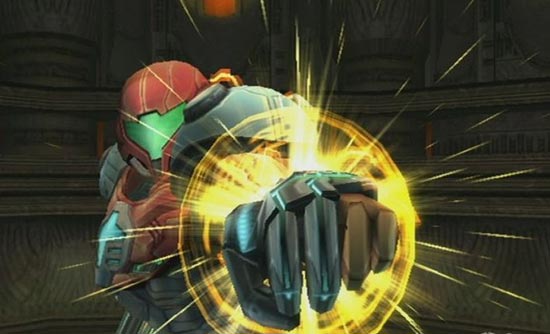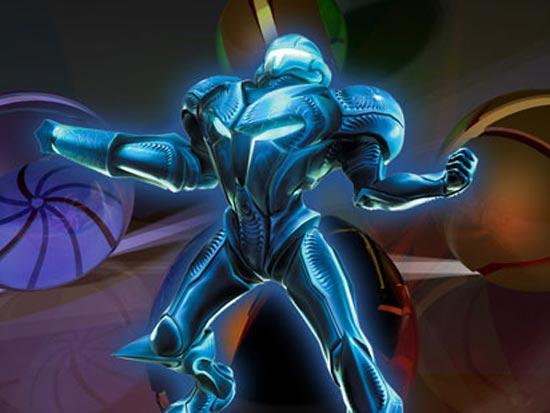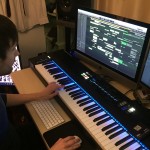I’ve been intentionally holding on to this one for awhile now. For those who don’t remember, “A Blast From The Past” is an interview series that revisits interviews I conducted while at Music4Games. We’re republishing them here on a somewhat monthly basis as they’re not longer available online. This time I thought it would be fun to celebrate the upcoming release of Metroid: Other M next week by posting the interview I conducted with Metroid Prime 3: Corruption composer Kenji Yamamoto and Retro Studios sound supervisor Scott Petersen.
In the interview we discuss the series’s transition from 2D into the 3D realm, the audio technology behind the Wii and the Prime series in particular, the interactions between the Japan-based Kenji Yamamoto and the Texas-based Retro Studios, and Nintendo’s lack of official soundtrack releases. This is the interview that I’m probably the most proud of, and I want to thank Nintendo once again for coordinating it and allowing us to republish it along with both Kenji Yamamoto and Scott Petersen for providing such thorough responses.
Re-reading this, I’m curious to hear how Yamamoto’s collaboration with Retro Studios is going for Donkey Kong Country Returns!
Check out the interview after the jump and let us know your thoughts.
Jayson: Retro Studios successfully redefined the Metroid universe with the release of Metroid Prime on the GameCube, which took the series from its side-scroller roots into the first-person shooter realm. While many familiar musical themes have been carried over from the original Metroid titles, does the audio team feel as though the Metroid sound went through as drastic a transformation?
Scott Petersen (Retro Studios): Since the sound transition was from on-chip sound synthesis for everything 2D Metroid to full resolution, sample based sound effects and streaming audio for our 3D Metroid Prime, I would say that it would be fair to describe the audio transformation as drastic. It was a bold idea to create a 3D Metroid from the start, so the audio had to support that.
Yamamoto: When we made the shift from side-scrolling Metroid to a first-person adventure Metroid, we needed to have more realistic sound effects and environmental sounds. On top of that, since I wanted to give a strong impression of the Metroid universe to players experiencing this realistic first-person game environment, the important original theme of Metroid had to be arranged as well. The original Metroid theme arrangement blended well with the newly composed Metroid Prime music to create the distinct Metroid Prime universe. With the side-scrolling Metroid in mind, I believed I could make it sound more realistic and well suited for FPS game. From that stand point, I feel it is fair to say that the music for Metroid has transformed drastically.
Jayson: Given that Metroid Prime 3: Corruption is the first title in the series developed for the Wii, describe the technological advances that have occurred in the audio department and how they have been implemented to improve the Metroid experience. Yamamoto-san, did your work on Excite Truck prepare you for the task of composing on the Wii?
Petersen: The two most important changes in developing audio for the Wii for us were that it gave us the opportunity to create a new set of audio development tools from scratch, and that we were able to significantly expand our audio RAM budget. The increased RAM size allowed us to use higher resolution audio samples throughout Metroid Prime 3 which made a significant positive impact on the overall quality and aesthetic of the audio experience.
Overall, the Wii’s audio capability is an evolution of what we had on the GameCube, but with additional horsepower. This additional horsepower of the system allowed us to use filters and pitch shifting more extensively. My favorite application of this is that we now have true Doppler shifting in all of our moving sounds. Every Space Pirate blaster shot (and most every other enemy projectile) has a loop sound attached to it, and you can really hear shots whizzing by your ear as they pass you by. I still smile every time that happens. Metroid Prime 3 is also the first Prime to have simple occlusion available inside of single rooms. We always occluded sounds from adjacent rooms, but now we have the power to place occlusion objects inside of rooms to separate interior areas from each other. You likely won’t notice this much when playing, but it really helped us isolate and refine how each section of a room felt without resorting to having to track a player’s position and turn banks of sounds on and off. While both of these technologies are old-hat for games, this was the first Prime that was able to utilize such tried and true methods of audio implementation.
We also made more extensive use of pre-mixed Dolby Pro Logic II streamed audio for our cinematic sequences. At the start of development, we had storyboarded out over 60 significant cinematics that we knew would require more involved and detailed audio than anything in Prime 1 or 2. Retro’s whole mantra during pre-production was to make Metroid Prime 3 more impactful, bigger and better than the previous Primes. This meant that the audio would have to stretch further than it had ever done to accommodate this more hyped up aesthetic. By pre-mixing our cinematics, we were able to achieve a much more polished experience that really helped immerse the player in the story and atmosphere of the game. By using streamed audio we had much greater range of material to choose from than if we only used sounds that would fit into our RAM budget. It was very satisfying when it all came together.
Yamamoto: As for the technical evolution of audio, because Retro developed the original sound tool for MP3: Corruption sound creation, I believe it led to an excellent result.
Regarding your question about Excite Truck being the good preparation for MP3: Corruption, to be honest, I don’t believe that working on the Wii Excite Truck soundtrack directly helped me prepare for the MP3: Corruption project. As you know, all of the music used in Excite Truck was hard-rock style music for 4-wheel drive racing.
To compose music for Metroid, I needed to use the different techniques to express the unique Metroid universe, and the instruments I used for it were also different from the Excite Truck project. My thinking patterns for these two projects were completely different. What helped me the most during my work for MP3: Corruption was that Retro and I had great cooperative structure and trust between us, mainly because we worked together on the first Metroid Prime and Metroid Prime 2.
Jayson: The Metroid franchise has always been known for its highly atmospheric and immersive gameplay experience, which has been aided by the electro-ambient scores and gritty sound effects provided by “Hip” Tanaka and Kenji Yamamoto. Describe some of the experiences the sound team had taking on such a well-established franchise and describe some of the challenges that were encountered and how the team got through them.
Petersen: There was a lot of pressure on Retro to make Metroid Prime 1 a great game. Prime 1 was a re-invention of a beloved Nintendo franchise by an unknown and unproven American development studio. Every effort was made to make the gameplay, art, design and audio as high quality as possible. I think that Clark Wen (Lead Sound Designer for Prime 1) did an amazing job of staying true to the 2D Metroid franchise while establishing a new and compelling aesthetic for the 3D Metroid Prime. The game really hit all the right notes from every discipline. This is especially amazing when you consider that in Prime 1, all the sound effects for a world had to fit inside of 6 MB! (This includes all of the player package, creature and world sounds). I think this limitation had a huge part in making Prime 1 sound as good as it does; every sound had to hold it’s own weight for it’s inclusion in the game. We were also very lucky to have been able to use Yamamoto-san for the music as it was his work in Super Metroid that evolved and refined the themes Tanaka-san had established in the original Metroid. Together, the hyper-refined sound design and Yamamoto-san’s distinctive musical style really cemented the audio style and quality of Metroid Prime.
Yamamoto: As Scott mentioned, the Retro sound team worked very passionately and positively to make Metroid Prime sound effects and environmental sounds even more realistic. For me, they are irreplaceable, extremely talented work partners.
We communicated through numerous email exchanges and video conferences–however, Austin, Texas (Retro) and Kyoto, Japan (myself) are so far away from each other, which is a big deal when developing game sound. Throughout the development of the Metroid Prime trilogy, it was one of the biggest issues I had.
Usually, I try to communicate with the staff more casually and frequently by occasionally visiting the studio in the afternoons and talking with the team to get updates and see how they are doing, but we couldn’t have that kind of casual communication in this case. Therefore, we couldn’t really share various key moments of development or the frantic moments when we went into the home stretch in the same place. It was very difficult for me.
Of course, we have been overcoming these difficulties by having numerous email exchanges and conference calls throughout the series. My partners for the Metroid Prime series, Clark Wen and Scott Petersen, are now my best (email) friends [Laughs]. They are very important work partners for me who do truly excellent jobs!
Jayson: Tell us about the interactive music system employed in Metroid Prime 3.
Petersen: Since we basically have wall to wall music during the entire game, our interactive music system is relatively simple in design but can get very complex in implementation. Essentially, we assign every room in the game a default piece of music which can change based on triggered events or what state the player is in (like if they are retraversing that room after getting the ship grapple and then they trigger a mini boss encounter). We define all of these music assignments in a single spreadsheet which is interpreted at runtime. Each room has a total of 10 available music slots and every musical transition that is triggered during gameplay is scripted into each room by hand. Most rooms are very simple, but some have a crazy amount of complexity due to all of layers of events we cram into them to make our retraversals significant and meaningful. We also added the ability to modify music volume based on static multipliers or a spline. This allowed us to duck the volume of the music and sound effects when the player speaks to NPCs or during the beginning or end of a cinematic.
Jayson: Since this is the final installment of the series, were there any intentional sound design decisions made that took this into consideration? This is the first Metroid title for home consoles to feature other bounty hunters and space travel. Did these gameplay mechanics have any bearing on sound design?
Petersen: Right from the start of pre-production design on Prime 3, we knew that this had to be the most impactful Prime yet. To help focus on this goal I spent a lot of time thinking about how the sound design and music could support this idea of the best Prime ever.
For the sound design, I identified that the core of our audio aesthetic is that everything Metroid should be highly stylized and/or synthetic. To push this further and to help carve out some new sonic territory, I wanted all of our stylized and synthetic sounds to have very little midrange content; I really wanted our world sounds to mainly be just highs and lows. This would ideally leave the middle range for creatures and weapons and music. While we didn’t slavishly follow this guideline for everything, it really helped all of our sound designers focus on a concrete aesthetic and sonic palette. It also came with a catchy description: “Sci-fu.”
A parallel consideration was that we knew from the outset that were going have Phazon everywhere and integrated into the entire game. This meant that we had to come up with a greater depth and variety of Phazon sounds (lovingly referred to as blue goo) than we had in the first two Primes. To do this, we sketched out a whole mess of loops based on what Phazon might sound like. We even had the opportunity to persuade our audio engineer Jim Gage to build a couple of Tesla coils, just so we could record the sounds in the hopes that it would be the secret element for our new Phazon. (It was pure bliss recording the sound of 30” arcs of high voltage electricity). We ended up taking the Tesla source and a variety of other sounds and digitally mangling them together to form the root of our new Phazon. This root sound was given to each sound designer who was to be creating anything remotely related to Phazon or Corruption for them to reference, use and abuse. The funny thing is that as a result of this you never really hear Phazon directly; it is much more about how Phazon corrupts and affects things than what it is in and of itself. This was not something I expected at the outset and was really part of the evolving concept of what it means to do sounds for video games.
As for the music for Metroid Prime 3, we knew we wanted to move in a more orchestral direction, but one that still maintained the game-y and synthetic nature of the previous Prime soundtracks. I sat down and identified some reference game and movie soundtracks and progressive electronic music to present to Yamamoto-san as possible style guides and references. Soon after I compiled my references, we found out that Yamamoto-san was coming to the States and was interested in visiting Retro Studios himself. This allowed me to present to him my musical references and style guide in person and for us to have a face-to-face dialog. He was very easy to work with and really understood our desired aesthetic. The cool thing was that after we got our musical direction discussion out of the way, we were able to geek out and exchange ideas about audio tools, music in general and even have a quick jam session. It was truly an honor that I got to play drums behind Yamamoto-san’s excellent guitar playing and our CEO Michael Kelbaugh’s kick ass bass playing.
Alright, so after all of this fun stuff, we also realized that we had some real work to do. The decision to include dialog was looming huge for us; this was to be Retro Studios and thus Nintendo’s most significant uses of voice acting, so we needed to get it right. I won’t go into the process we went through here, but suffice it to say that casting, recording, editing, effecting, implementing and maintaining voice in a game is job all to itself. Thanks to the Herculean effort of all of those involved with our voice recording, we were somehow able to pull it off while simultaneously creating and implementing assets for the rest of the game without imploding the entire audio department.
Finally, we knew right off the bat that Samus’s ship had to be a character in it’s own right. We were very lucky to have the talented Matt Piersall of Okratron 5000 doing the bulk of the ship sounds and I think he really nailed its character. 95% of the landing site cinematics you see in the game are a unique and custom creation. The level designers and artists created so many cool landing sites and vistas, that there was no way we were going to waste all that effort and just have a canned cinematic for every ship landing or takeoff. Instead we looked at each landing and takeoff as an opportunity to display the worlds of Metroid Prime 3 in a new and unique perspective. This meant that the timing, path and character for each landing and takeoff would be different, which meant that the audio would have to be custom built by hand for each instance. It was laborious, but I think well worth the effort.
Yamamoto: When I started working on MP3: Corruption, I visited Retro Studios in the early stages of development. I had an extremely productive meeting with the Retro sound team to discuss the music direction of MP3: Corruption. At this meeting, I learned what kind of music direction they wanted to take for this project, and it was very helpful for me to know that as I composed music. We communicated heavily on the sound development tools as well, and that helped us so much to understand the work process from there on.
As Scott mentioned, after the meeting, we had an opportunity to have a band-style improv session with Michael Kelbaugh and Scott Petersen. It was a great moment. In that musical session, I felt in my bones that music was and is the true universal language, and I knew I could cultivate an even deeper trust and friendship with them.
During that meeting, Retro communicated to us that they would like to use orchestral music as the music direction of MP3: Corruption. But if we used orchestral music for all of the sound, then we would lose the distinct musical atmosphere of the original Metroid. Therefore, after I came back to Japan, I tried to come up with answers for the questions such as, “How and where should we use orchestral instruments in the game? What kind of music should we build on from the original Metroid to maintain the real feel that this is still a part of Metroid series? How can we add new music elements for MP3: Corruption?” I tried to address these issues before I actually started working on it.
I already had the basic theory for the Metroid music design in my head, so organizing my thoughts on these questions was very intuitive. Of course, as you mentioned in your question, in this title, there are other hunters such as Gandrayda, Rundas and Ghor, so it was also one of my important objectives to create theme music for each bounty hunter to give players a strong impression of these hunters.
Jayson: As the composer for the Prime series and previous Metroid titles, how much interaction was there with the audio team based at Retro Studios? Were there certain requests you made of the team?
Yamamoto: Throughout the development of the Metroid Prime trilogy, we had numerous email exchanges and conference calls; however, we had the most frequent communication during the development of the original Metroid Prime because it was the first title we worked on with Retro. That meant it was necessary for us to communicate very closely as we decided the direction of Metroid music as it shifted from side-scrolling to first-person.
When we worked on Metroid Prime, it was the first time I worked with Retro, so it was very important for me to learn and understand how the Retro team felt about previous Metroid music, and what kind of preference they had for the first-person Metroid music. Retro sent me many music reference materials for first-person Metroid music direction, and I sent them many sound samples I created to get their feedback and consensus on the music direction. Based on that kind of frequent communication, I felt that the best way to approach this Metroid Prime music design project was the design theory I used for Super Metroid. It was my first time working with an American developer, so it required very heavy communication between us until we created a solid work flow and were comfortable with it.
Once the work flow was finalized, I requested they follow my approach for music creation, and the steps for how to handle it. When I sent the music I created to Retro, I gave them detailed instructions on how to play them, how and when to switch music for boss battles and other environmental sounds, what timing to use when fading music in and out, how to adjust the volume, and so on. We repeated the process of me reviewing their music and giving them other requests over and over to finalize the music. These were very important requests I made to Retro throughout the Metroid Prime trilogy.
Jayson: Please tell us how you go about composing a score for a Metroid title. Have there been any particular influences you’ve had in mind while composing for the series? Do you use primarily software-based sound banks or hardware? How do you decide which themes you will reuse from previous Metroid titles? Have you conversed with Hirokazu “Hip” Tanaka regarding his work on the original Metroid game on the NES?
Yamamoto: When creating the theme song for Metroid, I used the inspiration I felt when I saw the title screen of this game. To me, it’s very important to get inspired by the title screen when creating music, so I asked Retro to submit the title screen design at an early stage of the development.
Of course, I’m aware that this is a very difficult request to ask for at the very beginning of the development–when the game itself isn’t even finalized–so I knew what I’d get would not be polished enough to be the final title screen. But I could use the faint shape of the design and the rough movement as my inspiration to start designing the music.
I didn’t use the sound bank to get inspiration. I didn’t have any specific influences for composing Metroid music. I watched the footage first, and used the inspirations I got by playing the guitar and piano to organize the music. Of course, I’m sure my own music style itself has been greatly influenced by American rock music, and by my experience in a music band when I was in school. But as far as composing Metroid music goes, I only use the inspiration I get from the game footage I see.
That said, sometimes it’s very hard to get inspired just by watching footage. For times like that, I think about the footage while I’m riding my motorcycle to go home from Nintendo, and if I come up with a good melody, I stop immediately on the side of the road to record it on a voice recorder right away. It looks like I’m not thinking about much of anything while riding my motorcycle, so it’s easier for me to get inspired.
The music played in the background when Samus first receives an order from the Aurora Unit in MP3:Corruption is the music used in 1994’s Super Metroid. This music was also born when I stopped my motorcycle on the side of the road on my way home from Nintendo—I recorded the melody by singing. I’m sure people who drove by me were wondering what I was doing. [Laughs]
Next, I’d like to talk about how I decided to arrange the theme music from previous Metroid titles. For Super Metroid (1994), I was simultaneously performing three roles: working as the sound programmer to construct the program, creating sound effects, and composing the in-game music. Thanks to that experience, I now have the ideas to produce distinct Metroid music with a sound programmer’s ear, with a sound effect creator’s ear, and with the approach methodology and theory of a composer.
When arranging the theme songs from the previous Metroid titles to use in Metroid Prime, I decide on the direction of the music by following my own theory, which creates theme music emphasizing the Metroid universe we want the players to experience during their gameplay. In addition to that, I’m always trying to include at least one musical piece from the previous title to satisfy old Metroid fans. It’s like a present for them.
For example, the music we used by following this theory is the jingle when Samus appears on the screen, and the music we prepared as the present for Metroid fans are the pieces for the lava caves in Metroid Prime and underwater music for Metroid Prime 2. When we released Metroid Prime 2 in Japan, I read an internet message written by one of the fans: “There was a music from Super Metroid when I was underwater, and when I heard that, it brought back memories and made me cry.” When I saw that message, I felt that there are passionate Metroid fans out there who appreciate what I’m doing for them, and it gave me the confirmation that my direction wasn’t a mistake. That was a very happy moment.
I had several discussions previously with Mr. Hirokazu “Hip” Tanaka about music for NES Metroid. To tell you the truth, I partially used Mr. Tanaka’s approach—the one he used for the NES Metroid project–in the music for MP3: Corruption’s ending staff credits. In 1986, the music direction for NES Metroid was to maintain the distinct, dark Metroid universe music all the way from the beginning to the very end of the game (just before the staff credits starts showing up on the screen) to keep the player feeling scared and in the dark. The player does not hear the light-hearted, positive music at all until the ending credits start–then finally, at that point, he or she will hear the positive music and feel relieved.
If you don’t provide any happy music until the very end, it makes the player keep wondering, “When am I going to be relieved?” Then, finally, when the staff credits start with the positive, hopeful music, the player can relax. This was the design approach for NES Metroid music in 1986. In Metroid Prime 1 and 2, I did not use this approach for the staff credits music. But because MP3: Corruption is the last title in the series, I wanted to implement this approach for this title. If you’re interested, please complete the game and listen to the music for the ending credits.
Jayson: How were the schedule and deadlines for Metroid Prime 3? How did they compare to previous installments in the series? It seems that MP3 has been in development for quite some time.
Petersen: When we started pre-production on Metroid Prime 3, we had no hard information about the new Nintentdo Wii platform and so could only take guesses as to what we could and could not do from a hardware perspective. We proceeded smoothly along this path, and had even started some true production when Nintendo shared its plans with us regarding their new and revolutionary controller and the accompanying hardware. Once we had this information, it necessitated a re-think of some aspects of our planned design. This along with the growing pains associated with moving to a new hardware platform were the main source of our delays.
Metroid Prime 3’s development time of 3 years felt about right for a title on a new platform; we had plenty to learn along the way about what we could and could not do. Prime 2 was a shorter and arguably smoother development as everything we were dealing with was a known quantity. As I was not at Retro at the time, I cannot speak about the development of Prime 1.
Jayson: Given the fact that Metroid Prime 3 was originally intended as a launch title, how was the sound team able to refine the audio in the extra nine months of development time?
Petersen: We were of course disappointed with not being a launch title, but I know that if we had made launch, it would have been at the expense of overall game quality. Really, there was no “extra” time. We are always trying to add as much value as humanly possible to the player. Sometimes that just takes longer than you initially expect.
Yamamoto: Although the development schedule was extended, we didn’t gain much elbow room for music creation. This is because as the development schedule was extended and the game contents were improved, there was much more work for music creation as well [Laughs].
I believe that Retro’s sound team had a huge burden at the end of the development of MP3. Retro had to implement so many voices, and they worked really hard on every single sound effect included in the game until the very end. I really appreciate their hard work.
Jayson: Having been able to play through over half of Metroid Prime 3, I must say that I am impressed with both the music and sound design. I wanted to know what went into the decision to drop the main theme established in Metroid Prime and Metroid Prime 2 in favor of the new main theme for Metroid Prime 3?
Yamamoto: Thank you. I believe Retro’s hard work on sound effects and voice, and the early preparation for the project with meetings in Austin, TX, helped with that end result.
Regarding the main theme for each Metroid Prime title being different from each other, as I mentioned earlier, we partially use the arranged previous Metroid theme music in the Metroid Prime series by following the Metroid music creation theory. Therefore, each Metroid Prime has a completely different theme, to expand the variety. Each game’s universe has a different design as well, so I also had different inspiration for each of them.
Jayson: Nintendo is notorious for not releasing soundtrack albums for even its flagship titles, even in Japan. While there was Metroid Prime & Metroid Fusion album released years back, are there any plans to release the scores for Metroid Prime 2 or Metroid Prime 3? If there are no plans for a CD release, has anyone considered a digital distribution outlet like iTunes? You have many fans in the United States, and we are eagerly awaiting the release of your recent music.
Yamamoto: Please set your mind at ease. Nintendo is not intentionally being stingy with releasing soundtrack albums for our flagship titles. I believe it was just simply not good timing for album release, considering the development schedule and Metroid fans’ demand. As for the Metroid Prime & Metroid Fusion album, I had enough time in my schedule to support the development and studio recording when the record company approached us. I fully supported the CD cover creation as well.
We, Nintendo game sound creators, are not musicians whose main objective is to release albums. We create in-game music and sound effects to enhance the players’ gameplay experience. It’s sort of like we are playing roles of behind-the-scenes architects in game development. Unlike other musicians, our main goal is not about releasing albums. So we didn’t release many soundtrack albums in the past simply because the timing wasn’t right.
I’m very pleased to hear that there are many Metroid fans in the United States. I’m grateful for that, and I would like to thank every one of them from bottom of my heart for loving the Metroid series and having interest in the Metroid music. Thank you so much!
Jayson: What would your message be to the long-time series fans out there who have been with the series from the beginning, and have been looking forward to the release of Metroid Prime 3?
Petersen: Thank you so much for your patience and your support! We really hope you enjoy playing Metroid Prime 3.
Yamamoto: To Metroid fans who have been playing Metroid games for last 23 years since NES Metroid was released in 1986, Metroid fans who have been playing Metroid games for the last 13 years since Super Metroid was released in 1994, and new fans who have been playing Metroid Prime 3: Corruption in 2007 – I truly appreciate the fact that there have been Metroid fans for over 20 years.
I hope you like Metroid Prime 3: Corruption, and enjoy playing the game all the way through. Thank you very much.
Jayson: Yamamoto-san, are you at liberty to tell us what’s next for you?
Yamamoto: My next project hasn’t been decided yet, but I’m currently already involved in many Nintendo titles’ sound projects. I’m not only a composer, but I’m also taking the role of group manager for the sound development group, just like Mr. Kondo for Mario games. As I also worked on Brain Age titles to decide the music direction, I’m responsible for ensuring the sound quality of many Nintendo titles, making decisions for sound directions, etc.
Of course, I’m sure I’ll be involved in the next Metroid project, as well as whatever other projects require me as the composer.
Thank you very much for giving me this opportunity to talk a lot about Metroid Prime sound. I enjoyed it very much.
Again, thank you very much for being such passionate Metroid fans. I hope you will continue being Metroid fans. Thank you!
Tags: A Blast From The Past, Features, Interviews, Kenji Yamamoto, Metroid, Metroid Prime, Metroid Prime 3: Corruption, Nintendo, Retro Studios, Scott Petersen, Sound Design, Videogame










































http://www.youtube.com/watch?v=50Nzj9Wc3AM What an awesome track! Without a doubt he will do an amazing job as he did with the prime seires
What an awesome track! Without a doubt he will do an amazing job as he did with the prime seires 
You can’t tall me that’s not Kenji.
Interesting to see how this project has developed and grown over time. Thanks for the insightful interview.
[…] interviews made previously in the Music4Games site (offline several months ago). He started with a great interview he had with composer Kenji Yamamoto and Retro Studios sound supervisor Scott Petersen talking about […]
Twitter Trackbacks…
…
I raised an eyebrow at the bit where he mentioned Nintendo not being intentionally stingy regarding soundtrack releases. I do appreciate Nintendo trying to fashion an atmosphere, but the trait that made so much of their Game Boy, NES, and SNES output so memorable was the existence of a catchy melody–something that almost sounded like lyrics could accompany it. I am concerned that this isn’t as pronounced an ambition, these days.
Excellent interview. I’m hoping that every suggestion made to Nintendo concerning soundtrack releases is taken to heart! That said, I’m hope above all else that Nintendo manages to produce good music that warrants such a release.
[…] sound version is an interesting site which focuses on the area of audio for games, but which posted this interview with Kenji Yamamoto and Scott Petersen who worked on the music and sound effects for the game […]
http://www.originalsoundversion.com/?p=207
Thought that might be an appropriate little addition ‘from the past.’